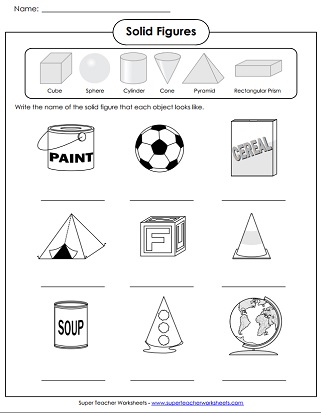Solids have faces, edges and vertices. The faces are the flat surfaces of solids. The edges are the places where two faces meet. The vertices are the corners. Singular vertex, plural vertices.
Solids are three-dimensional shapes. A prism is a solid, with two parallel faces called bases. The other faces are always parallelograms. The prism is named by the shape of its base. A solid is a pyramid if it has 3 or more triangular faces sharing a common vertex. The base of a pyramid may be any polygon. An edge is formed where two faces meet. A vertex is the point where three or more faces meet.
Students, I want you to tell me what you understand by plane shapes and solid shapes. Try to formulate working definitions for same.
Eg.
|
SOLIDS |
EXAMPLES IN ENVIRONMENT |
|
Cylinder |
Tissue roll |
|
Cuboid |
Chalk box |
|
|
|
|
|
|
|
|
|
|
|
|
|
|
|
5E Mathematics Lesson Plan (Grade 6)
Topic: Solids
Duration: 1 hour
Focus Question: What are the properties of solid figures?
Objectives:
-
Recognize faces, edges, vertices of solids and classify solids according to the number and shape of their faces.
-
Describe the physical world in terms of geometric concepts and talk about mathematical findings.
Materials:
ENGAGE (10 minutes)
Activity: Mystery Bag STEM Hook
-
The teacher presents a "Mystery Geometry Bag" with 3D objects inside (cube, pyramid, sphere, cylinder, cone, rectangular prism).
-
Without showing the items, students are given a few descriptive clues and must predict the shape.
-
Teacher asks:
-
“How do you think this object feels?”
-
“How many flat surfaces (faces) might it have?”
-
“Can it roll or slide?”
-
Purpose: Activates prior knowledge and sparks curiosity.
EXPLORE (15 minutes)
Activity: Hands-On 3D Shape Investigation (STEM Integration)
-
Students are given physical 3D shapes in groups
-
In pairs or small groups, they count and record the number of:
-
Faces (flat surfaces)
-
Edges (line segments)
-
Vertices (corners/points)
-
-
They classify solids by common properties (e.g., prisms vs. pyramids).
STEM Link:
-
Engineering: Discuss how engineers use solid shapes to design buildings, bridges, and packaging.
-
Students observe examples of real-world 3D shapes (soup can, dice, cone cup, etc.).
Differentiation:
-
Provide labeled diagrams for struggling learners.
-
Challenge high-achievers with less common solids like triangular prism or hexagonal prism.
EXPLAIN (10 minutes)
Activity: Concept Clarification with Chart
-
Teacher guides whole-class discussion using an anchor chart:
-
Definitions of face, edge, and vertex
-
Comparison chart of properties of solids
-
-
Students help complete a "Properties of Solids" table together.
Visual Aid:
| Solid | Faces | Edges | Vertices | Example |
|---|---|---|---|---|
| Cube | 6 | 12 | 8 | Die |
| Sphere | 0 | 0 | 0 | Ball |
Vocabulary: face, edge, vertex, prism, pyramid, sphere, cone, cylinder
ELABORATE (15 minutes)
Activity: 3D Shape STEM Challenge – "Design a Toy Package!"
-
In pairs, students choose a 3D shape to design a package for a toy (e.g., a cube for a puzzle game).
-
They justify their choice based on properties (e.g., “I used a rectangular prism because it stacks well on a shelf”).
Extension (for high-performing students):
-
Draw a net of the chosen solid figure.
-
Calculate surface area using formulas (if previously taught).
Differentiation:
-
Provide sentence starters: “I chose this shape because…”
-
Give struggling students cut-out templates of 3D nets.
Complete activities from teacher's blogsite
EVALUATE (10 minutes)
Three-Tier Evaluation Task
Objective: Assess ability to recognize, describe, and apply understanding of solid properties.
| Tier | Task | Level |
|---|---|---|
| Tier 1 | Match each solid figure to its correct number of faces, edges, and vertices (use a worksheet with visual aids). | Support |
| Tier 2 | Complete a table classifying solids and describe their real-world use (e.g., “A cone is used in ice cream packaging”). | On-level |
| Tier 3 | Write a short explanation: “Why might an engineer choose a cylinder shape for a tunnel?” | Enrichment |
Closure (5 minutes)
-
Revisit the Focus Question: “What are the properties of solid figures?”
-
Use a “Turn and Talk”:
-
“Tell your partner one shape and describe its faces, edges, and vertices.”
-
-
End with a quick Kahoot quiz or exit ticket with 3 questions:
-
What is a vertex?
-
Name a shape with no edges.
-
Which solid shape has 6 faces and 8 vertices?
-






No comments:
Post a Comment